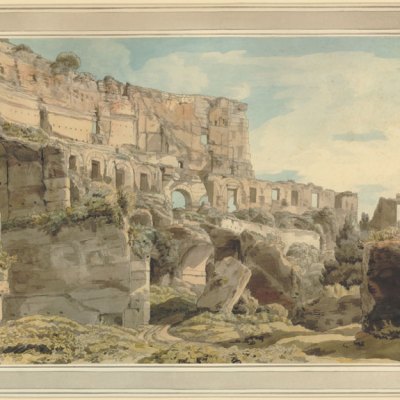Commissioning Karl Friedrich Schinkel to build your palace must have been a nightmare. In 1838, he was asked to design a country retreat for Alexandra Feodorovna, wife of Nicholas I of Russia. The palace was to be built on a precipice overlooking the Black Sea, at Orianda in the Crimea. And this setting was too tempting for the Prussian architect, whose own paintings often taper into prettier versions of the dramatic vistas you find in the landscapes of his contemporary, Caspar David Friedrich.
A chromolithograph made from one of Schinkel’s watercolour presentations – on display at the Scottish National Gallery’s new exhibition, ‘Visionary Palaces’ – has the palace perched on its rocky outcrop, like Friedrich’s Wanderer, surrounded by trees, and looking out to sea beneath darkening clouds. Schinkel’s plans blended classical and oriental designs. Long colonnades, covered in mosaics and studded with precious gems, would be interwoven with gardens, culminating in an Ionic temple at the centre, beneath which would be housed a museum of local antiquities. This extravagant design was, as the catalogue puts it, ‘politely declined’.
Crimean Museum, Beneath the Temple Pavillion in the Centre of the Palace Complex, Viewed Looking Towards the Grand Pool in the Imperial Garden Court (published 1948), W. Loeillot; after Karl Friedrich Schinkel. Scottish National Gallery

The exhibition also features Schinkel’s unrealised 1834 plans for converting the Athenian Acropolis into a residence for the King of a newly independent Greece. These palaces are ‘Visionary’ because they express Schinkel’s sense of what public architecture ought to be: embedded in its local landscape, and traditions, but animated by modern innovation and ideals; a ‘vigorous mediation’ as he put it in Das Architektonische Lehrbuch. Schinkel never visited either Greece or Russia, so he was dependent on artistic reproductions, and his own preconceptions. Visionary, too, in the sense that, never built, they survive only as Schinkel’s vision. ‘Nothing more than a beautiful dream,’ as he put it.
Interior Perspective of the Great Hall, Looking Towards the Garden Court (published 1843), Heinrich Asmus; after Karl Friedrich Schinkel. Scottish National Gallery

Not that he didn’t leave a substantial physical legacy, from the Gothic Revival Schloss Rosenau, to the various public works whose construction he oversaw as Prussia’s Privy Building Officer from 1815 onwards: monuments to the dead of the Napoleonic Wars at the Kreuzberg and Spandau; the neoclassical Altes Museum in Berlin’s Lustgarten. If his tastes were flexible and his later style tended toward yoking them together, the most abiding strain was the neoclassical. Or to be precise, the Philhellenic.
In part, this was a reaction to the predominant Roman strain in the neoclassicism of Prussia’s recent French occupiers. But Schinkel also saw in ancient Greek architecture a model for the renascent Prussian state, in which, he wrote in 1825, an informed and engaged polis might make use of the ‘objects of nature in order to bring an elevated way of life for the individual and for the people in general’. His designs for the Acropolis could, therefore, have been something of an apogee. A ‘Principal View’ shows modern structures threaded through the Periclean ruins to make a unified complex, providing shade or cover as winter or summer demanded. In one of the presentations, a sea terrace reproduces the Caryatid Portico, and it is perhaps only on second viewing that we notice the glass between the columns on the dais next to it.
Perspective of the Principal View of the Royal Palace on the Acropolis: Section Through Line A.B. on the Ground Plan Looking West (published 1840), Schnechten; after Karl Friedrich Schinkel. Scottish National Gallery

Again, these designs were too lavish for a Greek government still dependent on cash loans from the Great Powers (sound familiar?). It seems appropriate, then, that this exhibition is hidden away in the gallery’s basement – in an alcove, walled off from the permanent collection, so tiny that you begin to take the occasional presence of a tartan-trousered attendant, making their rounds, personally. Schinkel’s grand style once again cramped by reality.
Perspective View of the Sea Terrace, Showing the Caryatid Portico and Glazed Semi-circular Side Bay (published 1847), W. Loeillot; after Karl Friedrich Schinkel. Scottish National Gallery

He might not have minded. As he wrote in 1825, regarding his programmatic painting A View of Greece in its Prime, even looking out at these imagined vistas might edify the viewer, providing them a window onto ‘the full extent of the culture of a highly educated people’. If the most interesting aspect of this exhibition is the exquisite lithographed presentations – the perspective views Schinkel imagines for his buildings – they are most intriguing for the worlds we see in their backgrounds. The sorts of worlds, this former scenic artist is telling us, in which these buildings might actually get built. The Acropolis sea terrace looks out onto the Aegean, a few distant white sails fluttering in its breeze. We glimpse the Ionic temple in the centre of the palace at Orianda, through a colonnade, nestling amid the ‘Imperial Garden Court’ and a ‘Grand Pool’. A couple of swans in the ‘Grand Pool’ arch their white wings, and paddle.
Perspective View of the Grand Pool to the North of the Imperial Garden Court, Looking Towards the Podium Housing the Crimean Museum (published 1846), Heinrich Mutzel; after Karl Friedrich Schinkel. Scottish National Gallery

‘Visionary Palaces: Designs by Karl Friedrich Schinkel’ is at the Scottish National Gallery, Edinburgh, until 12 June.



